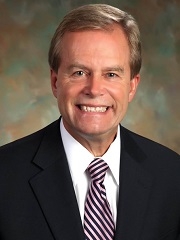Main article: Who Should Own a Healthcare Organization’s Cost Transformation Efforts?
At Rocky Mount, Va.-based Carilion Franklin Memorial Hospital, part of Carilion Clinic, leaders drive accountability for cost transformation by connecting the at-risk compensation of vice presidents, department chairs, and other physician leaders to overall organizational performance.

To stay on track, leaders review a monthly balanced scorecard with metrics that align to the hospital’s strategic plan, says William D. Jacobsen (pictured at right), former administrator. (Lance Robinson, managing director and leader of Kaufman Hall’s Performance Improvement practice in Chicago, says scorecards generally should be shared every two to four weeks).
In 2011, leaders at Carilion Franklin Memorial recognized an opportunity to address uncompensated care: Data revealed that one in five uncompensated-care patients used the emergency department (ED) six or more times a year. The hospital addressed this issue by:
- Partnering with community groups to improve access to primary care, medication, and transportation
- Offering nonemergency patients in the ED the option to receive care from an on-site primary care clinic within the hour (more than two-thirds took the option)
- Hiring a patient navigator to assist patients in getting health insurance and educate them about primary care options
These efforts helped provide a $5 million turnaround in operating income for the hospital. “Every dollar saved on uncompensated care goes directly to the bottom line, plus patients are getting access to the care they need,” says Jacobsen, who is now CEO of lumination! LLC in Roanoke, Va.
Reducing costly readmissions has been another area of focus. After reviewing the processes that contributed to readmissions among congestive heart failure (CHF) patients, a dedicated clinical team determined that simple interventions like providing bariatric scales and patient education at discharge could help curb readmissions. The team also increased the supply of a diuretic provided to CHF patients after discharge from 30 days to 90 days.
To assist in paying for the initiative, leaders drew funds from the federal government’s Small Rural Hospital Improvement Grant Program.
Clinical teams used a similar approach to reduce readmissions among patients with chronic obstructive pulmonary disease or pneumonia. Thanks to these efforts, the hospital has not had to pay readmission penalties to Medicare during the past three years, Jacobsen says.
The clinical teams are not disbanded once they reach their cost transformation goals—instead, they go into “maintenance mode” and monitor the results over time. “If the metrics fall out of acceptable controls, we reactivate the teams to address the issue and bring them in back in line—that’s how we sustain it,” Jacobsen says.
Interviewed for this article:
William D. Jacobsen, FACHE, former administrator, Carilion Franklin Memorial Hospital, Rocky Mount, Va., and now CEO, lumination! LLC, Roanoke, Va.
Lance Robinson, managing director and leader of Kaufman Hall’s Performance Improvement practice, Chicago.





